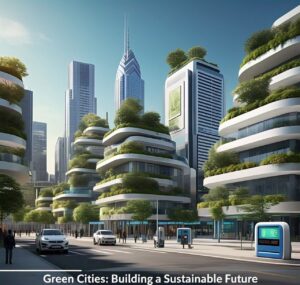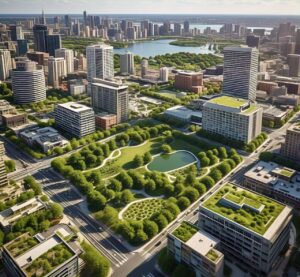In the rapidly evolving landscape of urban development, Smart Cities have emerged as beacons of innovation, sustainability, and enhanced quality of life. By leveraging cutting-edge technology and data-driven solutions, these cities aim to address urban challenges and create more efficient, livable environments. In this article, we explore the top 10 Smart Cities in the world, highlighting their unique initiatives and the role of comprehensive design services in their development.
Table of Contents

1. Zurich, Switzerland
Zurich consistently ranks at the top of Smart City indices, thanks to its robust digital infrastructure and commitment to sustainability. The city has implemented intelligent traffic management systems, energy-efficient buildings, and extensive public transportation networks. These initiatives have enhanced urban mobility and reduced environmental impact.
2. Oslo, Norway
Oslo is renowned for its environmental focus, particularly in reducing carbon emissions. The city promotes electric vehicle usage through widespread charging infrastructure and has invested in smart lighting systems to conserve energy. Oslo’s dedication to green technology underscores its position as a leading Smart City.
3. Singapore
Singapore’s Smart Nation initiative exemplifies its commitment to integrating technology into daily life. The city-state employs sensors and data analytics to manage traffic flow, monitor air quality, and enhance public safety. Additionally, Singapore has developed smart housing solutions to improve living standards for its residents.
4. Helsinki, Finland
Helsinki has embraced open data policies, allowing citizens and businesses to access city data to foster innovation. The city utilizes digital platforms to engage with residents, gather feedback, and co-create solutions. Helsinki’s focus on transparency and collaboration has solidified its status as a Smart City leader.
5. Copenhagen, Denmark
Copenhagen aims to become carbon-neutral by 2025, implementing smart solutions in energy management and transportation. The city has developed intelligent traffic systems to reduce congestion and encourages cycling through smart bike-sharing programs. These efforts contribute to Copenhagen’s reputation as a forward-thinking Smart City.
6. Amsterdam, Netherlands
Amsterdam’s Smart City initiatives focus on sustainability and innovation. The city has implemented smart grid technology to optimize energy consumption and supports startups in developing urban solutions. Amsterdam’s collaborative approach fosters a dynamic environment for Smart City advancements.
7. New York City, USA
New York City leverages technology to enhance public services and infrastructure. The city has deployed smart water meters, waste management systems, and connected traffic signals to improve efficiency. These initiatives aim to create a more responsive and sustainable urban environment.
8. London, United Kingdom
London’s Smart City strategies encompass data-driven transportation management and environmental monitoring. The city utilizes real-time data to optimize public transit and has introduced smart street lighting to reduce energy consumption. London’s integration of technology into urban planning enhances its residents’ quality of life.
9. Tokyo, Japan
Tokyo focuses on smart mobility solutions and disaster resilience. The city has developed advanced public transportation systems, including autonomous vehicles, and employs technology to monitor and respond to natural disasters. Tokyo’s emphasis on safety and efficiency underscores its Smart City status.
10. Berlin, Germany
Berlin’s Smart City initiatives prioritize sustainable urban development and digital innovation. The city supports projects in smart energy, mobility, and information and communication technology (ICT) to enhance urban living. Berlin’s commitment to integrating technology into city planning fosters a vibrant and sustainable urban environment.
The Role of Comprehensive Design Services in Smart Cities

The success of Smart Cities hinges on the seamless integration of technology, infrastructure, and design. Firms like ShapeSpace Associates play a pivotal role in this integration by offering a suite of services tailored to the needs of modern urban environments:
- Architecture Design: Innovative architectural solutions that incorporate smart technologies and sustainable practices to create functional and aesthetically pleasing structures.
- Interior Design: Designing interior spaces that enhance user experience through smart systems, ergonomic layouts, and sustainable materials.
- Construction Design: Implementing advanced construction methodologies and materials to build resilient and efficient structures aligned with Smart City principles.
- Infrastructure Design: Developing intelligent infrastructure systems, including smart grids, transportation networks, and water management solutions, to support urban efficiency.
- GIS Services: Utilizing Geographic Information Systems to analyze spatial data, optimize urban planning, and manage city resources effectively.
By leveraging these services, ShapeSpace Associates contributes to the development of Smart Cities that are not only technologically advanced but also sustainable and livable.
Q1: What defines a Smart City?
A Smart City utilizes digital technology and data analytics to enhance the efficiency of services and infrastructure, improve sustainability, and elevate the quality of life for its residents. This includes intelligent transportation systems, energy-efficient buildings, and responsive public services.
Q2: How do design services contribute to the development of Smart Cities?
Design services are integral to Smart City development as they ensure that technological advancements are harmoniously integrated into the urban fabric. Architecture and interior design create spaces that are both functional and conducive to smart technologies, while construction and infrastructure design focus on building resilient and efficient systems. GIS services provide critical spatial analysis to inform urban planning and resource management.
Conclusion
In conclusion, the top Smart Cities around the globe exemplify how technology and thoughtful design can converge to create urban spaces that are efficient, sustainable, and enriching for their inhabitants. Firms like ShapeSpace Associates are.



